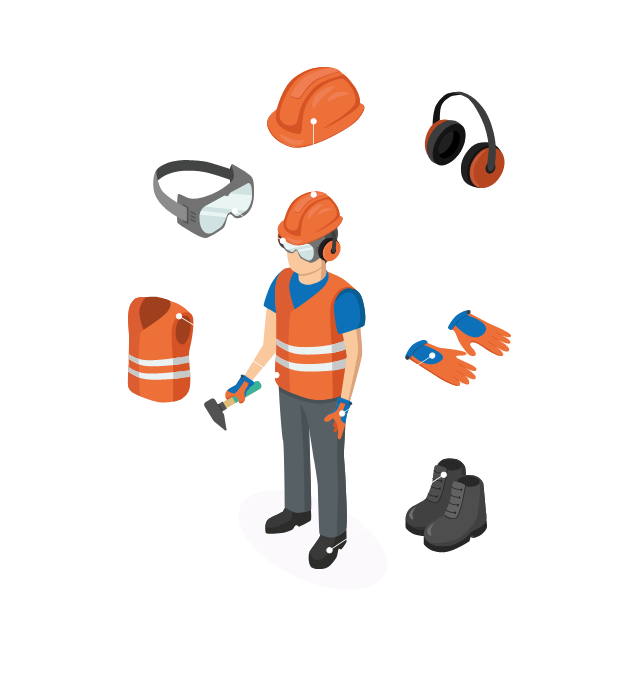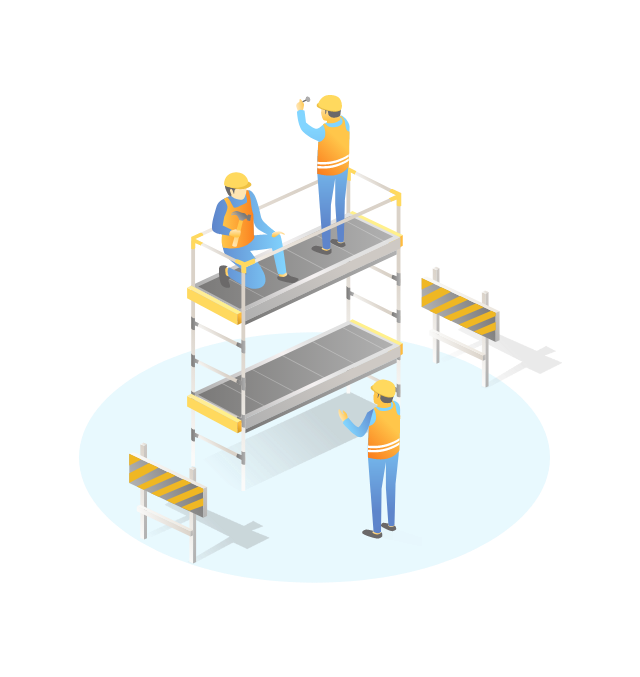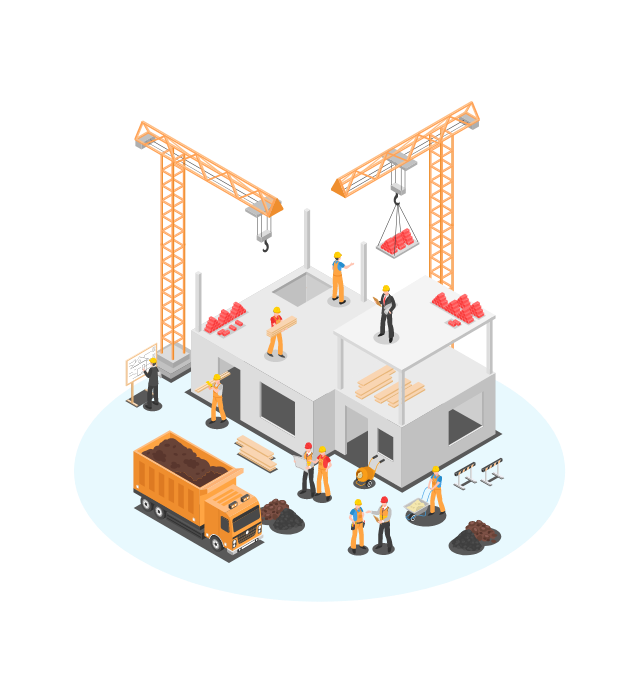India's burgeoning construction industry plays a decisive role in the nation’s infrastructural and industrial metamorphosis. Recording a whopping contribution of 2670 INR Billion to India's GDP in the first quarter of 20201, construction industry is catalysing the country’s economic development. Spurred by government initiatives such as 100 Smart Cities, highway construction, railways expansion, and housing and urban development projects, the sector is estimated to grow by 7.1% each year and emerge as the third largest globally by 20252.
Employing 51 million people, the construction sector is also the nation's second largest employer2. However, despite technological advancements in most of the sectors, construction work is still labour-intensive, high-risk with workers working on complex tasks requiring high-intensity operations, which always leads to hazards.
A study by British Safety Council reveals that nearly 80% of workers work in unsafe environment and on-site deaths are 20 times higher in India than those in Britain3. Nearly 48,000 workers die in the country due to occupational accidents out of which 24.2% is recorded in the construction industry4. Since majority of the workforce belongs to the bottom of the social pyramid, any injury and resultant expenditure adds to their financial burden having a negative impact on their quality of life. All these facts necessitate an urgent need for better industrial safety systems and risk assessment technologies across all construction sites.
Hitachi, one of the leader in manufacturing and construction sectors, is not only committed to the safety of its workers but workers across the nation and world. By innovating automated industrial safety monitoring systems that monitor workers’ safety in real time and instantly alert the stakeholders upon threat detection, Hitachi Social Innovation Business is not only enabling the digital empowerment of the construction sector but also assuring the safety of workers for a better Quality of Life.
The construction industry reports almost 6x fatalities and 2x injuries per hour worked relative to a manufacturing industry(5)
Most common reasons for injuries - falls, falling material and objects, electrical hazards, etc.
Most accidents involving eyes, legs, feet, and toes are often fatal.
Several head and neck injuries caused by falling from a height or being struck by vehicles & other moving plants and equipment.
Occupational Safety and Health Administration (OSHA), an agency of the United States Department of Labor, stresses on workers wearing Personal Protective Equipment (PPE) for enhanced safety. In the Indian context, the Bureau of Indian Standards (BIS) also recommends wearing hardhats, goggles, and gloves in typical construction environments where there is a potential for a head injury from impacts, falling or flying objects, or electrical shock.
Wearing safety gear such as hardhat, safety vests, gloves, and goggles is an effective protective measure for minimizing the risk of serious injuries.
In construction accidents, the hardhats protect workers by resisting penetration by objects, absorbing shock from direct blows to the head by objects and reducing electrical shock hazards. Safety goggles prevent exposure of eyes to molds, fungi or rodent droppings. Safety gloves prevent burns and electrical shocks. Despite the vital role of these safety gears in protecting life, injuries still occur due to lack of wearing any protective equipment owing to lack of training & awareness amongst workers and employers.

National Safety Council (NSC) - Generates, develops and sustains a voluntary movement on Safety, Health and Environment (SHE) at the national level.

Bureau of Indian Standards (BIS) - Undertakes research and studies to publish many SP and IS codes on construction safety practices.

National Legislation -
The Factories Act requires employers to provide basic safety measures including -

The Factories Act requires employers to provide basic safety measures including -

National Legislation -
National Building Code of India, 2005 provides guidelines for regulating construction activities for a building across the country.
Traditional safety management methods such as risk analysis and safety training have proved to be ineffective in construction safety. Keeping in mind the vital role of industrial safety gears in minimizing risk of injuries, most industries are adopting industrial safety monitoring systems to ensure their compliance. However, most of these systems are plagued by issues that put a question mark on their efficacy.
Firstly, object detection which is the principal component of this system and used for detecting safety gears suffers from the problem of false/missed detections and miss classifications. These failures prove to be extremely costly and result in wrong safety monitoring alerts and safety hazards.
Secondly, video stream-based processing to reduce detection errors is yet to be adapted for industrial safety, despite mainstream adaptation in general Artificial Intelligence (AI) tasks. Finally, unlike existing areas of computer vision, where there is an availability of large public datasets, best of existing research works in detecting industrial safety gears is restricted to mostly hardhats due to lack of large datasets.
To counter these challenges and help industries efficiently monitor their workers’ safety, Hitachi India Pvt. Ltd., Research & Development (HIL R&D) Centre has innovated an automatic construction surveillance system that monitors the safety compliance of construction workers in real time by ensuring safety gears are appropriately worn.
The solution introduces safety gear detection dataset consisting of 5,000 images with annotations for four safety gears including helmet, jacket, goggle and glove. Leveraging Hitachi's technological prowess, the solution addresses video level wrong/missed detections and miss classifications. For instance, to address wrong or missed detection, it exploits temporal information from contiguous frames by propagating boxes through trackers. To address video level miss classification, it proposes to condition class label of detected object in the current frame based on the results of re-identification of objects (Re-ID) computed in prior frames. Such a conditioning mechanism helps in propagation of class labels, thereby reducing the miss classification. Finally, HIL R&D conducted extensive experiments to show that the construction surveillance system works effectively under complex conditions of illumination, posture and occlusions.
For humanitarian, legal and economic reasons, construction organizations are increasingly paying attention to enhancing workers' safety at sites. Injuries not only result in loss of working hours and delay in completion of projects but also negatively impact the organization's image and its credibility as an employer in the competitive market. Further, with the advancement of vision technologies, most industries are moving towards automatic safety monitoring systems with real-time monitoring capabilities which in turn improves worker safety and reduces labor costs.
Leveraging its Social Innovation Business for Powering Good, Hitachi is committed to enhancing the safety of the workers across India and the world for a better Quality of Life. Hitachi’s trusted OT x IT expertise is helping industries adopt the latest digital practices and technologies for maximised productivity and safety of workers in the 21st century.
1 - https://tradingeconomics.com/india/gdp-from-construction
2 - https://www.investindia.gov.in/sector/construction
3 - https://www.counterview.net/2019/05/indias-80-construction-sites-unsafe.html
4 - https://www.indiatoday.in/pti-feed/story/48000-die-due-to-occupational-accidents-yearly-study-1090427-2017-11-20
5 - https://www.ijert.org/research/safety-in-indian-construction-IJERTV3IS111031.pdf